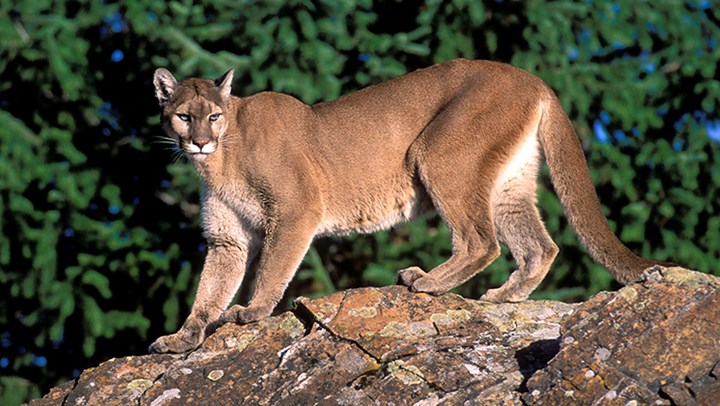
by Brian McCombie - Saturday, July 28, 2018

The State of Nebraska recently approved a new mountain lion hunt, while Wyoming’s Governor signed off on that state’s first grizzly bear hunt in 44 years. The animal rights extremists immediately started agitating against the hunts, using their usual emotional appeals. But, in fact, both of these hunts show that protecting and managing wildlife through science-based hunting regulations can and does produce sustainable wildlife populations.
As reported by the Lincoln Journal-Star, “As many as eight mountain lions may be felled in Nebraska next year during the state's second-ever hunting season for the big cats. The Nebraska Game and Parks Commission (NGPC) unanimously approved the season.” The article explained the decision followed months of study by NGPC staff, who found roughly 59 cats were inhabiting Nebraska’s Pine Ridge, an elevated area in the northwest corner of the state.
According to a NGPC news release, "The season will allow the population to remain resilient and healthy, while halting growth or moderately reducing the population size. This will initiate a reduction of the population density in Pine Ridge to one similar to that of other states that allow mountain lion hunting."
Wyoming Governor Matt Mead recently approved his state's first hunt for grizzly bears in more than four decades. Once on the endangered species list, Wyoming grizzly bears were removed from federal protections in 2017. Why the removal?
As Gov. Mead told the Associated Press (AP), grizzlies have "exceeded their recovery goals for over a decade." As the AP noted, the new hunt will “allow up to 22 grizzlies to be killed in a wide area east and south of Yellowstone and Grand Teton National Parks. The Wyoming Game and Fish Commission heard from hunt supporters and opponents before voting unanimously in favor of it in May.”
Reopening a Wyoming grizzly bear hunt was controversial—mostly because animal rights extremists and anti-hunters don’t seem to care about the science behind these decisions. According to The Missoulian out of Montana, for example, the bears were removed from federal protection in 2017 because the “population of grizzlies in and around Yellowstone National Park reached at least 700 animals [which was over the recovery population goal]… That turned over grizzly management to the state wildlife agencies of Montana, Idaho and Wyoming,” the states where grizzlies are found.
As noted by the Washington Post, when federal protection for the big bears was initiated in 1975, “about 136 of the animals remained in and around Yellowstone National Park.”
Animal rightists and anti-hunters have already condemned the new hunt, circulating a petition opposing it and claiming that “without those [past ESA] protections and a policy of peaceful coexistence, grizzlies will disappear again.”
Yet, according to the Washington Post, “Federal biologists say limited hunting is unlikely to harm the overall grizzly population in the Yellowstone area, and Wyoming wildlife officials … described the [hunt itself] as conservative.”
Of course, anti-hunting, animal rights extremists have made a living opposing conservation-based, sustainable hunts despite what the science says. Unfortunately, their wrong-headed, emotional appeals seem to get traction. How else do you explain the lack of a black bear hunt in Florida, which has an ever-increasing population of black bears?
For background, Florida’s black bears were given protection under Florida’s endangered species laws in 1974, as their numbers had dwindled to just 300 animals statewide. Through the years, black bear numbers surged to an estimated 4,000 animals.
In 2015, Florida reopened a bear season as bear nuisance and bear damage complaints were on the rise as were bear-vehicle accidents. Approximately 300 bears were taken in the 2015 hunt.
Animal rights types in Florida quickly turned to emotional, unscientific appeals to stop any future hunts, as summarized in a petition various groups started to circulate. "Without Endangered Species Act protection, the Florida black bear could once again find itself on the precipice of extinction," the petition said, in part.
Another bear hunt was set to be held following the 2015 hunt, but the Florida Fish and Wildlife Conservation Commission (referred to as the FWC) to postponed the 2016 hunt. Instead it asked agency biologists and staff to prepare a revised management plan to present to the FWC in two years.
As the FWC report on the 2015 bear hunt noted, “FWC staff took a conservative approach to reinstating a limited bear hunt in Florida that was scientifically based and carefully regulated to ensure the level of harvest was completely sustainable while achieving the goal of stabilizing large, growing bear populations.”
All of which was apparently not good enough for the FWC commissioners, in no small part as future bear hunts were and are being actively and loudly opposed by two of the top anti-hunting groups in the country—the Center for Biological Diversity and the Humane Society of the United States–as well as the home-grown Stop the Florida Bear Hunt. Sadly, they seem to be wielding a great deal of influence, given that, scientifically speaking, a Florida bear hunt appears completely sustainable.
E-mail your comments/questions about this site to:
[email protected]
